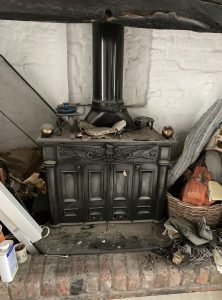
A trip out to Suffolk for this week’s blog! This job involved sweeping a rare retro stove, a Franklin Majestic 98-1800 Wood-Burning Stove. I had not come across one of these stoves before and it proved easy enough to sweep, but very dirty as it had not been swept for some time. This example was in an address in Lidgate, close to Bury St Edmonds. It was an unusual old, thatched timber framed property. However, what made it unusual was that the thatch had been covered by a corrugated tin roof, which had been painted black. The builder who was renovating the property told me an interesting story as to how and why such thatched buildings came to be covered with corrugated tin roofs. He told me that during the war many thatched properties had their rooves covered with corrugated tin to protect them from German 5th columnists and spies, who might set fire to their rooves, which might aid as a guide to German bombers. This said he could not swear to the veracity of the story!
I did try and research the stove on the internet, but could find very little information about Franklin Majestic Stove, other than they were made in America. But what I did find was information about the development of Franklin stoves: The Franklin stove is a metal-lined fireplace named after Benjamin Franklin, who invented it in 1742. It had a hollow baffle near the rear (to transfer more heat from the fire to a room’s air) and relied on an “inverted siphon” to draw the fire’s hot fumes around the baffle. It was intended to produce more heat and less smoke than an ordinary open fireplace, but it achieved few sales until it was improved by David Rittenhouse. It is also known as a “circulating stove” or the “Pennsylvania fireplace”. The two distinguishing features of Franklin’s stove were a hollow baffle (a metal panel that directed the flow of the fire’s fumes) and a flue that acted as an upside-down siphon.
The stove was about 30 inches (76 cm) tall, with a box shape. The front was open, except for a decorative panel in the upper part of the box. The back of the box was to be placed a few inches away from the flue (chimney). On the bottom panel there were several holes to allow the smoke to escape; these were connected to the chimney. The panels were bolted together with iron screws through pre-cast ears. Inside there was a small, thin rectangular prism that would force the smoke into the holes. The plates were all made from iron.
Franklin’s stove sold poorly. The problem lay with the inverted siphon: the smoke had to pass through a cold flue (which was set in the floor) before the smoke could enter the chimney; consequently, the smoke cooled too much, and the stove did not have a good draft. The inverted siphon would operate properly only if the fire burned constantly, so that the temperature in the flue was high enough to produce a draft.
A later version, designed by David Rittenhouse, solved many of the problems Franklin’s original stove had, and became popular. Franklin’s fame outweighed Rittenhouse’s, though, so history remembers the Franklin Stove rather than the Rittenhouse Stove. The smaller Latrobe stove, often referred to as a Baltimore Heater, was patented in 1846 and became popular.


 My name is Paddy McKeown, I am a retired police officer (Detective Sergeant – Metropolitan Police), turned chimney sweep. I have completed training with ‘The Guild of Master Chimney Sweeps’, and Rod Tech UK (Power Sweeping).
My name is Paddy McKeown, I am a retired police officer (Detective Sergeant – Metropolitan Police), turned chimney sweep. I have completed training with ‘The Guild of Master Chimney Sweeps’, and Rod Tech UK (Power Sweeping).




Comments are closed.